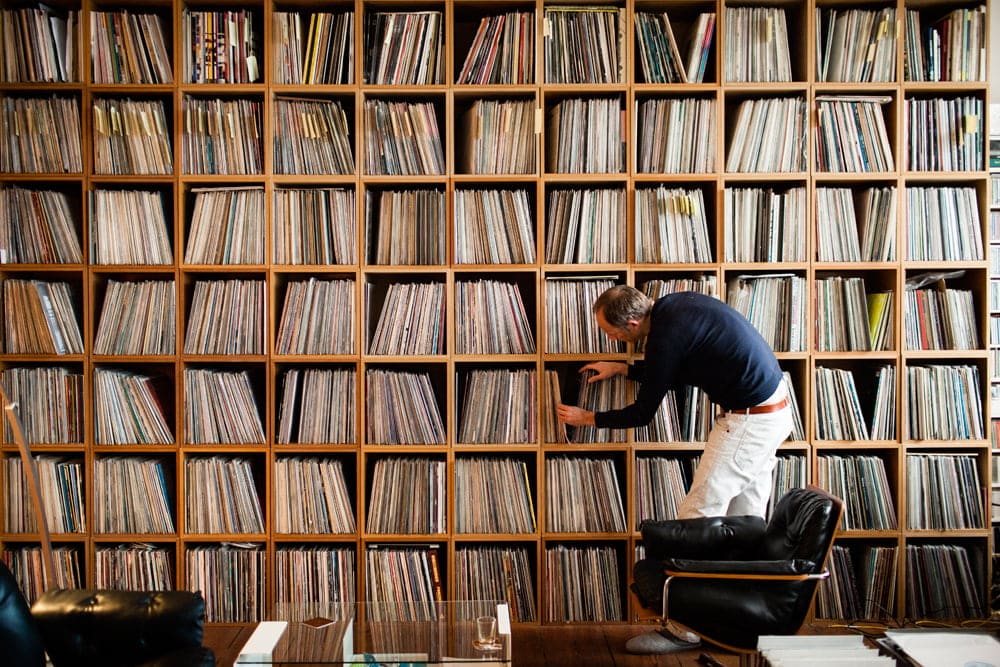The ways we listen to music are always changing, but the people who feel the need to amass as much of it as possible never go away. Yet, with so many of these forms now online and digital-based, what’s physically left to collect?
Nothing has changed more in the last century than recorded sound and the ways in which it is delivered to the listener’s ear. Like so many of the “discontinuous” inventions (inventions that make possible dramatic changes) we explore in this magazine for the collectibles they bring about, Thomas Edison is at the root of this story, as well.
Thomas Edison invented the phonograph in 1877. His work on a telephone transmitter and the keyboard telephone inspired him to make sketches for a device that would both record and playback sound impulses engraved onto tinfoil. Some months later, John Kruesi, an Edison- employed machinist built the first tinfoil phonograph, based on Edison’s sketches. A verse of “Mary had a little lamb” is reportedly the first phonograph recording to be made and played back.
Always quick to move on to his next invention, Edison sold his manufacturing and sales rights to the phonograph to the Edison Speaking Phonograph Company in early 1878 to turn his attention to the electric light bulb, only to return to the technology in late 1886 as new innovations in playing recorded music threatened to make his technology obsolete just as the market was heating up.
In 1886, the Volta Graphophone Co. was granted a patent for a device they called the ‘graphophone’ based on a wax-coated cardboard cylinder. Edison responded the following year with his “Improved Phonograph” based on a solid wax, rather than a wax-coated cylinder. The refinement and subsequent manufacturing of devices to deliver music continued down the cylinder path unchallenged until German inventor Emile Berliner received a U.S. patent in 1886 for a machine to record sound by tracing a lateral—as opposed to the phonograph’s vertical—groove of even depth, onto a cylindrical drum. Shortly thereafter, Berliner replaced the cylinder with a flat disc, and recorded music started down an alternative path.
For nearly twenty years, competition existed between the flat record and the cylinder, with the disc leading by a narrow edge. Some companies such as Edison and Columbia issued recordings on both formats. Today, both of these formats – cylinder and flat record – and the devices that played them leave a trail of collectibles that tell the musical history of early recorded sound.
By 1910, the record had overcome the cylinder as the preferred format, and 78rpm records emerged as the “standard rate.” Any flat disc record made between about 1898 and the late 1950s and playing at a speed around 78 revolutions per minute is called a “78” by collectors. While innovative, the 78 was limited to a single recorded song, with roughly three to five minutes of playtime per side.
That limitation was removed in 1948 with the introduction of the 33rpm record by the Columbia Record Company. With tighter grooves and a slower spin rate, the 33rpm record allowed for the recording of full-length albums. Sales soared as new music was recorded on these extended format discs. Ten years later, 78s accounted for only 2% of U.S. record sales, and by 1959 were no longer being produced in this country, leaving behind a half-century of recorded, collectible music in this format.
Ten months after Columbia Record Company introduced the 33rpm record, RCA Victor released the new 45rpm record in 1949. These 7-inch discs could hold about 4-5 minutes of recording on each side, perfect for a single song like the 78, but recorded at a much higher quality, and more affordable than higher-priced 33 LPs. They were also the perfect play for the jukeboxes turning up in restaurants, bars, and social clubs across the country, and the new record players finding their way into American homes.
Over the next 30 years, consumers and collectors had much to choose from between 33s and 45s, but records took up a lot of space and were vulnerable to use and the elements over time. Enter the compact disc (CD) in 1982.
CDs were a game-changer for all but hard-core vinyl collectors. Many music buyers, myself included, were happy to sell off their warped, scratched albums at tag sales and rebuild their music collection with these smaller-size, more durable, and better-quality recordings. When portable and in-dash CD players came on the market, the CD even muscled out 8-tracks and cassette tapes, leaving in its wake even more formats for music lovers to collect.
Technological evolution is on display in most object-based collections but what happens when the object evolves beyond a physical form? That’s already happened in the music industry, where today more music is purchased online as a digital file than albums and CDs purchased at a brick and mortar or online store to be played on a stereo or CD player. New music is still being made and consumed at record-breaking levels but the delivery devices, distribution, recording formats, and packaging for that music are not the same market drivers for collectors in the digital age of the 21st century as they were in the 20th century when vinyl in all its speeds was king.
So, I have to wonder what collecting music in the digital age will look like without the physical representations that have traditionally accompanied the consumer sale of music and have defined the collector experience for over a century. Is a downloadable digital file of licensed music as collectible as the music you buy that is wrapped in an album cover as defining as the music itself? Interested in hearing your thoughts.





Related posts: